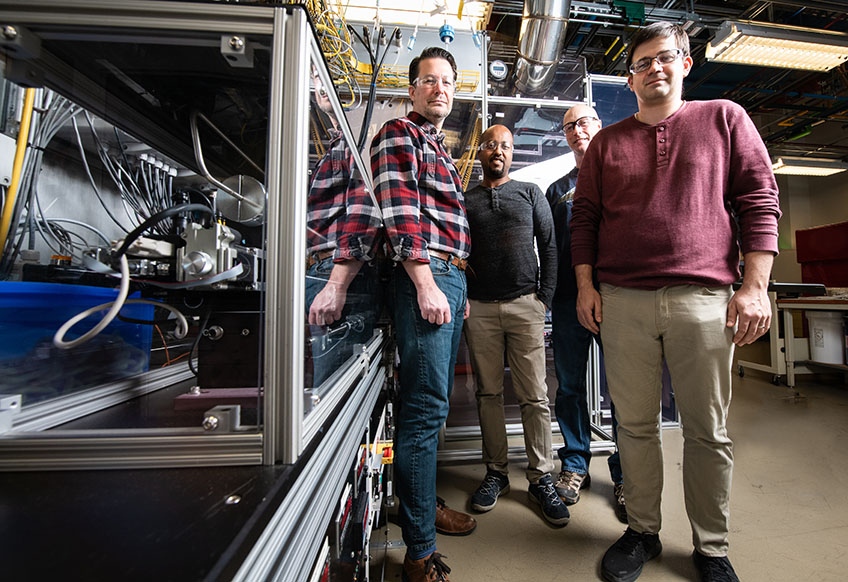NREL Scientists make 'impossible' solar material

Scientists grow AlInP and AlGaInP for the first time using hydride vapour phase epitaxy (HVPE)
Scientists at the National Renewable Energy Laboratory (NREL) have achieved a technological breakthrough for solar cells previously thought impossible.
The scientists successfully integrated an aluminium source into their hydride vapour phase epitaxy (HVPE) reactor, then demonstrated the growth of the semiconductors AlInP and AlGaInP for the first time by this technique.
“There’s a decent body of literature that suggests that people would never be able to grow these compounds with hydride vapour phase epitaxy,” said Kevin Schulte, a scientist in NREL’s Materials Applications & Performance Center and lead author of a new paper highlighting the research. “That’s one of the reasons a lot of the III-V industry has gone with MOVPE, which is the dominant III-V growth technique. This innovation changes things.”
The article, 'Growth of AlGaAs, AlInP, and AlGaInP by Hydride vapour Phase Epitaxy' appears in the journal ACS Applied Energy Materials.
III-V solar cells are expensive and so have mainly been used in space applications but researchers are developing techniques to reduce those costs.
One method pioneered at NREL relies on a new growth technique called dynamic HVPE (D-HVPE). Traditional HVPE, which for decades was considered the best technique for production of LEDs and photodetectors for the telecommunications industry, fell out of favour in the 1980s with the emergence of MOVPE. Both processes involve depositing chemical vapours onto a substrate, but the advantage belonged to MOVPE because of its ability to form abrupt heterointerfaces between two different semiconductor materials, a place where HVPE traditionally struggled.
That’s changed with the advent of D-HVPE.
The earlier version of HVPE used a single chamber where one chemical was deposited on a substrate, which was then removed. The growth chemistry was then swapped for another, and the substrate returned to the chamber for the next chemical application. D-HVPE relies on a multi-chamber reactor. The substrate moves back and forth between chambers, greatly reducing the time to make a solar cell. A single-junction solar cell that takes an hour or two to make using MOVPE can potentially be produced in under a minute by D-HVPE.
Despite these advances, MOVPE still held another advantage: the ability to deposit wide band gap aluminium-containing materials that enable the highest solar cell efficiencies. HVPE has long struggled with the growth of these materials due to difficulties with the chemical nature of the usual aluminium-containing precursor, aluminium monochloride.
The researchers always planned on introducing aluminium into D-HVPE, but first focused their efforts on validating the growth technique.
“We’ve tried to move the technology forward in steps instead of trying to do it all at once,” Schulte said. “We validated that we can grow high-quality materials. We validated that we can grow more complex devices. The next step now for the technology to move forward is aluminium.”
Schulte’s co-authors from NREL are Wondwosen Metaferia, John Simon, David Guiling, and Aaron J. Ptak. They also include three scientists from a North Carolina company, Kyma Technologies. The company developed a method to produce a unique aluminium-containing molecule, which could then be flowed into the D-HVPE chamber.
The scientists used an aluminium trichloride generator, which was heated to 400degC to generate an aluminium trichloride from solid aluminium and hydrogen chloride gas. aluminium trichloride is much more stable in the HVPE reactor environment than the monochloride form. The other components—gallium chloride and indium chloride—were vapourised at 800degC. The three elements were combined and deposited on a substrate at 650degC.
Using D-HVPE, NREL scientists previously were able to make solar cells from GaAs and GaInP. In these cells, the GaInP is used as the “window layer,” which passivates the front surface and permits sunlight to reach the GaAs absorber layer below where the photons are converted to electricity. This layer must be as transparent as possible, but GaInP is not as transparent as the AlInP used in MOVPE-grown solar cells. The current world efficiency record for MOVPE-grown GaAs solar cells that incorporate AlInP window layers is 29.1 percent. With only GaInP, the maximum efficiency for HVPE-grown solar cells is estimated to be only 27percent.
Now that aluminium has been added to the mix of D-HVPE, the scientists said they should be able to reach parity with solar cells made via MOVPE.
“The HVPE process is a cheaper process,” said Ptak, a senior scientist in NREL’s National Center for Photovoltaics. “Now we’ve shown a pathway to the same efficiency that’s the same as the other guys, but with a cheaper technique. Before, we were somewhat less efficient but cheaper. Now there’s the possibility of being exactly as efficient and cheaper.”
The US Department of Energy’s Solar Energy Technologies Office funded the D-HVPE research.


































